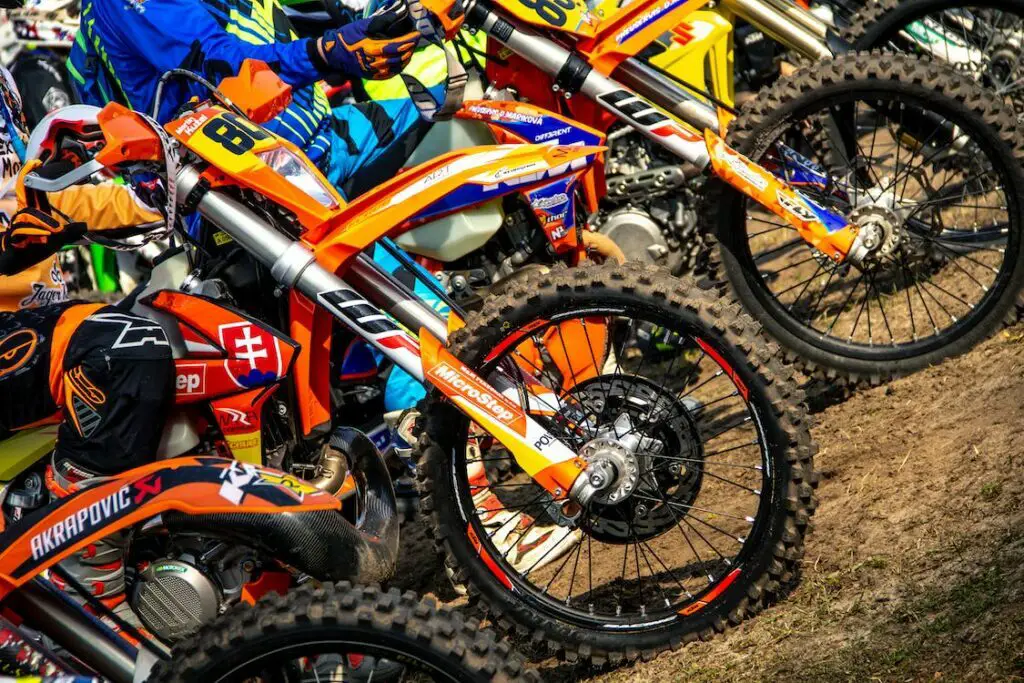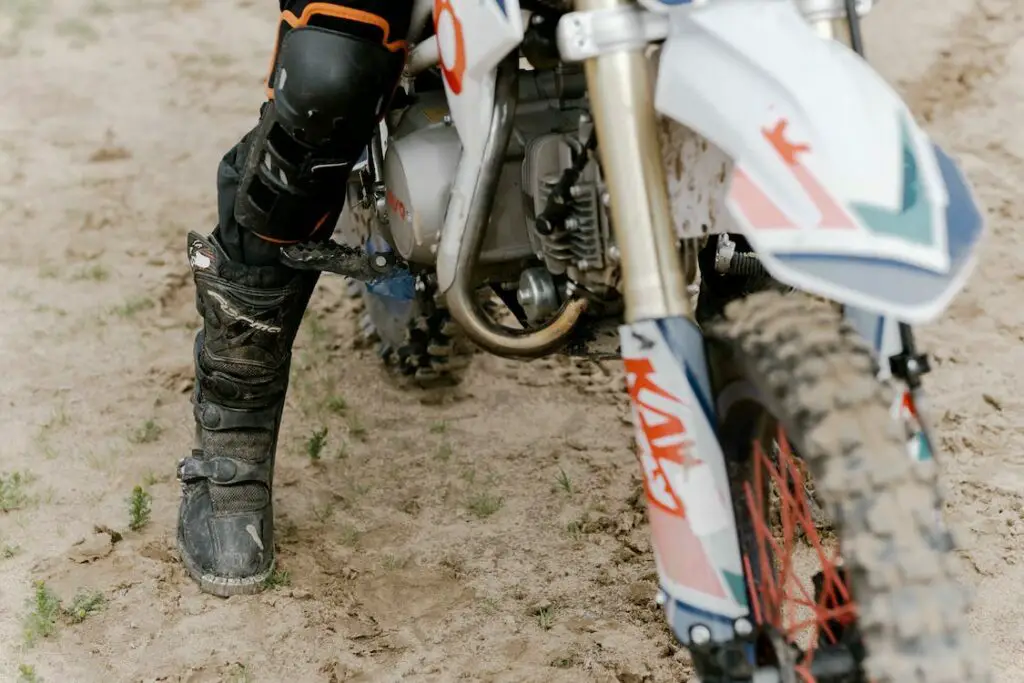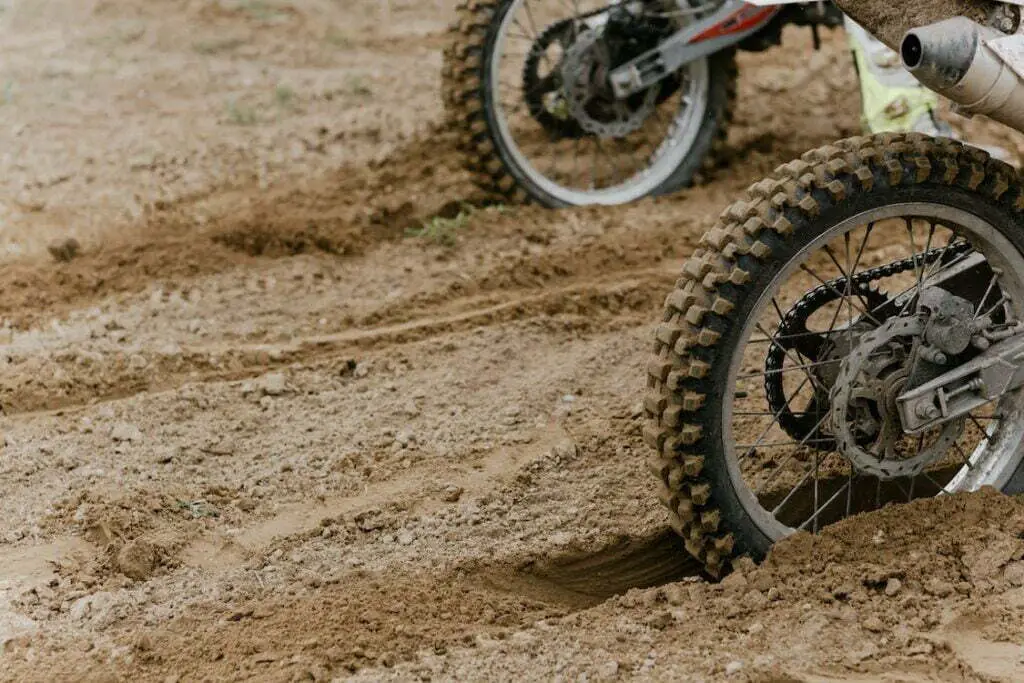It’s one of the most common questions I hear from beginner riders or those planning to buy dirt bikes, followed by the ongoing debate of which is better – tubed or tubeless tires.
Majority of dirt bikes use spoke wheels because of their durability in various terrains and weather conditions. Since spoke wheels automatically come with tubes, dirt bikes commonly have tubed tires. Although some dirt bikes now come with tubeless tires, tube-tired models are still the most popular.
How to tell if my dirt bike has tubes?
There are two ways to determine if your tires have tubes or not.
First, determine the type of your dirt bike’s wheels. Are they spoke or alloy?
As mentioned, dirt bikes often have spoke wheels, so if your bike has spoke wheels, it comes with tubes. However, some spoke-type wheels do not come with an inner tube. To be sure, deflate your tires and check manually.
On the other hand, alloys don’t come with spokes, so you won’t find tubes there.
You can also distinguish tubeless tires from tubed tires by checking their valve stems. A valve stem is a small orifice on your tire leading to the internal air chamber that allows you to inflate or deflate your tires.
Image courtesy of fabrikasimf
Tubed tires usually have metal valve stems with a nut on the outside threads to keep the valve sealed. On the other hand, tubeless tires have rubber and seals around their valve stems.
The valve stem in a tubed tire is attached to the wheel itself, so when you change tires, you’ll also have to replace your valve stem. Tubeless tires have valve stems separate from the tire, usually in the rim.
If you’re buying a brand-new or unmodded secondhand dirt bike, you can ask the seller if the bike has tubed or tubeless tires.
Why do dirt bikes still have tubed tires?
The answer is off-road endurance.
Spoked wheels (tubed tires by default) are designed to withstand the tension caused by uneven and rough terrains. With their spokes acting as springs, dirt bikes can easily handle off-road terrain due to their flexibility and tolerance.
Spoke wheels also feature shock absorption to prevent damage from rocks, debris, and uneven terrain. By distributing the force of impact, the spokes keep the tires in good shape.
Spoke wheels are also easier to repair. If you bend a rim or crack some spokes while driving, you can easily replace the parts instead of replacing the whole wheel. A huge benefit for drivers doing damage-prone or endurance-testing activities.
Lastly, the reason could be aesthetic reasons. Some riders love to keep the classic look that spoke wheels have built for dirt bikes through time, especially for vintage dirt bikes.
Tube vs: tubeless tires: what’s the difference?
| Tubed Tires | Tubeless Tires | |
| Pros | Durable and flexible for off-road drivingEasy to repair and replaceIdeal for motorcycles with spoke wheels | More lightweightHas better stability for fast ridingBetter puncture resilienceBetter air pressure retention |
| Cons | Requires regular maintenanceSome riders have reported tubes blowing out while riding | Not all tubeless tires are suitable for off-road driving |
Tubed Tires
Image courtesy of cottonbro studio
Tubed wheels are built for heavy-duty driving, so they need to include a separate section for keeping the tire pressure intact. If the rim of a tubed tire bends, you can still continue riding your bike and repair the damage later.
Inner tubes in tubed tires are made of natural and synthetic rubber. Hence, this combination makes the tube flexible enough to follow the tire’s shape yet durable enough to withstand dirt bike weight.
Traditional spoke wheels weren’t built for tubeless setups since they had too many holes for rim lacing. It would be impossible to place an airtight seal somewhere on the tire without overlapping some anchor points.
On the downside, pneumatic tires require more maintenance. Removing the wheel and the tires and then patching the tubes takes a lot of time. No one has the time today to patch their bike’s tubes three times a day every day (sometimes even more).
Some riders have also shared stories of tube bursts while riding at high speeds. If you’re planning to push the limit, you might want to avoid tubed tires for safety reasons.
Tubeless Tires
Image courtesy if Matias Henriquez
Not all dirt bikes need tubes, especially the newer models. Thanks to precision engineering, some tubeless tires can now match the durability that tubed tires are known for.
One of the best things about tubeless tires is their strong resilience to punctures. The thicker tire layer of tubeless tires acts as your bike’s “safety bag” when you accidentally drive on a sharp rock or nail. When you check your tires, you’ll find the culprit safely stuck there in the thick outer layer of your tire.
With tubeless tires, you won’t also need to carry a spare tube for replacement. Keep some small plugs with you, and you’re good to go.
Tubeless tires are also less susceptible to loss of air pressure, unlike tubed tires that lose pressure after only a few days of riding. It is because tubeless tires have tighter air seals.
Can you convert a tubed tire to a tubeless one (and vice versa)?
Technically yes, but it is not advisable. Not all tubed tires are compatible with a tubeless wheel, and vice versa. Plus, the conversion process is expensive and complicated.
If you want a dirt bike with tubeless tires, you can buy a model already fitted with them.
However, if you insist on switching your tires, you’ll have to search for a conversion kit suitable for your bike.
When switching from tubeless to tubed tires, it’s safer to go for a setup with one less load and speed rating than what the tubeless tire claims. The tube and tire will create extra heat the faster you drive, so you’ll want to give some extra space to prevent your tube from bursting.
While some riders have successfully converted tubed to tubeless tires, it’s not something I’d recommend, especially for beginner riders. There’s a lot of sealing and compatibility testing to do that’s not worth the time and effort. It’s not safe either.
Should I go for tubed or tubeless tires for my dirt bike?
The most debatable question comes with the most cliché answer: it depends. Your choice of tires depends on how you intend to ride your dirt bike.
Tubed tires are perfect if you’re leaning towards more off-road driving with your dirt bike.
However, if routine driving and highways are more your jam, then you’re better off with tubeless tires. Today, they are more common because of their durability, ease of repair, and ability to withstand high-speed driving.
Summary
Dirt bikes traditionally come with tubed tires because of their proven durability and endurance in off-road driving. Plus, they’re easier to repair.
However, new dirt bike models are switching to tubeless tires because of their convenience, lighter weight, and better puncture resistance.
Choosing between tubed and tubeless tires ultimately comes down to your driving preference. Tubed tires are more suitable for off-road drivers, while tubeless tires are ideal for city or high-speed driving.



